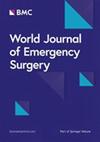经瘘灌洗在胸腔镜、胃镜联合治疗自发性食管破裂中的疗效观察
IF 5.8
1区 医学
Q1 EMERGENCY MEDICINE
引用次数: 0
摘要
自发性食管破裂(SER)是一种罕见且死亡率高的严重急症,其治疗方法一直存在争议。回顾性分析金陵医院2014年1月至2024年7月行VATS清创引流术的SER病例。根据胃镜下是否经食管瘘置管,将患者分为灌洗引流组和引流组。术前行液体复苏、胸腔镜纵隔切开、胸廓清创。术后处理包括禁食、肠内营养、抗感染药物和维持体液和电解质平衡。监测指标包括生命体征、实验室检查结果、术后并发症及其他相关因素。共纳入24例患者,其中灌洗引流组11例,引流组13例。灌洗引流组30天死亡率较低,并发症和不良事件较少,炎症因子降低较快,但成本较高。两组患者机械通气时间、住院时间、ICU住院时间差异无统计学意义。灌洗引流法提高了引流效率,降低了炎症程度,改善了SER预后。然而,本研究存在一定的局限性,需要进一步的多中心前瞻性研究来优化治疗和降低成本。本文章由计算机程序翻译,如有差异,请以英文原文为准。
Effects of the lavage through fistula in treatment of spontaneous esophageal rupture by combined thoracoscopic and gastroscopic management
Spontaneous esophageal rupture (SER) is a rare and severe emergency with high mortality, and the treatment algorithm remains controversial. This retrospective study analyzed SER cases that underwent VATS debridement and drainage in Jinling Hospital from January 2014 to July 2024. Patients were divided into Lavage-Drainage and Drainage groups based on whether they received a lavage tube cathetering through the esophageal fistula under gastroscope. Preoperative fluid resuscitation, thoracoscopic mediastinotomy, and thoracic debridement were performed. Post-operative management included fasting, enteral nutrition, anti-infective agents, and fluid and electrolyte balance maintenance. Monitoring indicators included vital signs, laboratory test results, postoperative complications, and other relevant factors. A total of 24 patients were enrolled, with 11 in the Lavage-Drainage group and 13 in the Drainage group. The Lavage-Drainage group had lower 30-day mortality, fewer complications and adverse events, and a faster reduction in inflammatory factors, but a higher cost. There was no significant difference in the length of mechanical ventilation, hospital stay, and ICU stay. The Lavage-Drainage approach enhanced the drainage efficiency, reduced the inflammation level, and improved the prognosis of SER. However, this study has some limitations, and further multi-center prospective studies are needed to optimize the treatment and reduce costs.
求助全文
通过发布文献求助,成功后即可免费获取论文全文。
去求助
来源期刊

World Journal of Emergency Surgery
EMERGENCY MEDICINE-SURGERY
CiteScore
14.50
自引率
5.00%
发文量
60
审稿时长
10 weeks
期刊介绍:
The World Journal of Emergency Surgery is an open access, peer-reviewed journal covering all facets of clinical and basic research in traumatic and non-traumatic emergency surgery and related fields. Topics include emergency surgery, acute care surgery, trauma surgery, intensive care, trauma management, and resuscitation, among others.
 求助内容:
求助内容: 应助结果提醒方式:
应助结果提醒方式:


